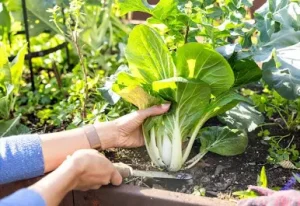
Bok choy are a Brassica, member of the cabbage family, which also includes cauliflower, broccoli, and Brussels sprouts. Other common names include pak choi, pok choi, and Chinese cabbage.
These plants are biennials and can be prone to bolting. Bolting in the first year is commonly caused by cold weather followed by a period of rising temperatures
Bok choy is not a fan of hot weather, so gardeners typically grow two crops, one in spring and another in fall. For spring plantings, start seeds indoors 4 to 6 weeks before your last spring frost date. Count backward 50 days from your first frost and direct seed for fall harvests.
Sow more every 2 weeks throughout spring and again in fall to achieve a long, continuous supply of these delicious plants.
Starting indoors
- Sow 1-2 seeds per cell in standard trays or use soil blocks.
- Sow seeds about a ¼-½ inch deep.
- After germination, thin to one seedling per cell.
- Snip the extras; don’t pull them, or you might damage the roots of the remaining plants.
- Harden them off before transplanting them into the garden beds.
- They can be transplanted outside once a set of true leaves has been established and soil temps outside are 50°F (10°C).
Direct Sow
- Prepare the bed with compost.
- Sow seeds ½ inch deep, about 3 inches apart, in rows 18 inches apart.
- Once plants are 4 inches tall, thin to a spacing of 6–9 inches apart, eat the ones you remove
Harvest
DO not wait to long to harvest. Start harvesting your bok choy when the plants are 12 to 15 inches tall. Use a sharp knife and trim an inch or two above the soil. The remaining plant will sprout and grow a new. You can also cut the outer leaves individually. The inner leaves will continue to grow, and the plant will continue to sprout new growth.
